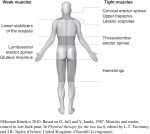Pilates is a great modality to regain muscular balance in the body. Muscular balance is crucial for injury recovery, prevention and optimal performance of the body.
At the Body Gallery all new clients receive a full postural assessment. This provides the client and trainer with highly useful information that will help us find a focus point and goal for our program design. Our trainers use Dr. Janda’s approach to muscle imbalance patterns when assessing our clients.
There are three patterns we look for.
1. Upper Crossed Syndrome: Symptoms seen are a forward head position, increased cervical lordosis, rounded shoulders and increased thoracic kyphosis (as seen in the picture below). This muscular imbalance can lead to weak cervical flexors, rhomboids and lower traps while causing the upper traps, levator scapula and suboccipitals to become hyperactive and tight.
2. Lower Crossed Syndrome Type A & B: Symptoms seen for Type A are an anterior pelvic tilt, increased lumbar lordosis and knee flexion. Symptoms seen for Type B are minimal lumbar lordosis, kyphosis, head protraction and hyperextension in the knees. In both types muscular imbalance is seen as weak abs and glutes with hyperactive and tight hip flexors and thoracumbular extensors.
Type A
Type B

3. Layer Syndrome: This imbalance is more complicated to see visually but is apparent as the body moves and we see how the muscles are functioning. Generally we will see weak mid/lower traps, deltoids, infraspinatus, teres major/minor and lats. In response the cervical erector spinae, upper traps, levator scapula, thoracumbular erector spinae and hamstrings are hyper active and tight.


